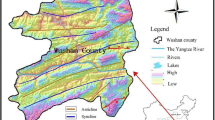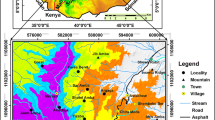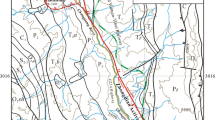Abstract
Factual data for 70 rapid, giant landslides since 1900 show that the occurrence of these landslides was largely predisposed by tectonics, geological structures, lithology and topography, and often triggered by rainfall and earthquakes. In terms of mobile behavior, the giant landslides can be classified into three types: slides, slide-flows and flows. It is found that each type of landslide was constrained to certain geologic and topographic regimes. There are good correlations between kinematic parameters of landslides and slope geometries, which confirm the important role played by topographical condition in the mobile behavior of landslides. Moreover, it is also found that each type of landslide presents distinct geotechnical characteristics in terms of nature of the slip zone and properties of sliding mass. Brief analyses of five typical cases illustrate that landslide mechanisms can be conceptually depicted by failure mechanisms of their slip zones prior to onset of movement and following energy conversion during movement. Problems and questions related to experience in China suggest that comprehensive and systematic investigation and study on rapid giant landslides are urgently needed.


















Similar content being viewed by others
References
ABWR (1976) Wolongsi landslide and follow-up remediation (in Chinese). Administrative Bureau of the Wei River. Landslides 1:147–157
Anderson SA, Sitar N (1995) Analysis of rainfall-induced debris flows. J Geotech Eng 121(7):544–552
Chai HJ, Liu HC, Zhang ZY (1995a) Event inventory of landslide dams in China (in Chinese). Geol Hazards Environ Protect 6(4):1–9
Chai HJ, Liu HC, Zhang ZY (1995b) Landslide dams induced by Diexi earthquake in 1933 and its impact on environment (in Chinese). Geol Hazards Environ Protect 6(1):7–17
Chen XC, Huang JB, Wei LW (1992) Countermeasures against geological hazards: lessons learnt from Touzhaigoi landslide (in Chinese). Chinese Geol Hazards Prevent 3(3):83–91
Corominas J (1996) The angle of reach as a mobility index for small and large landslides. Can Geotech J 33:260–271
Cruden DM, Varnes DJ (1996) Landslide types and processes. In: Turner AK, Schuster RL (eds) Landslides. Investigation and mitigation. National Academy of Sciences, Transportation Research Board Spec Rep 247:36–75
Cui P, Zhong DL, Li Y (1997) Zezhu Landslide-debris flow in Meigu County, Sichuan (in Chinese). Mountain Res 15(4):282–287
Dong BP (1986) Another new large scale landslides in Tufengyan, Majiaba of the Three Gorges, Yantze River (in Chinese). Bull Soil Water Conserv 6(5):33–40
EBSMP (1994) Major tectonic systems in China. Distribution of strong earthquake epicenters and major earthquake zones in China (in Chinese). Atlas of China. Editorial Board of Sino Maps Press. Sino Maps Press, Beijing, pp 8–9
Fang YS (1984) Dynamic study of super landslides (in Chinese). Hydrogeol Eng Geol 6:20–24
Fell R, Hungr O, Leroueil S, Riemer W (2000) Geotechnical engineering of the stability of natural slopes, and cuts and fills in soil. In: Proc GeoEng Conf, November 2000. Technomic, Lancaster, vol 1, pp 21–120
Feng XC, Zou JS (1984) Cause of Hongtupo landslide and its countermeasures (in Chinese). Soil Water Conserv 4(3):24–26
Gao JG, Zhong LX (1993) Event inventory of geological disasters (in Chinese). In: Ma ZJ (ed) Natural disasters and countermeasures in China. Science Press, Beijing
Ge ZY, Chen YX, Duan LH, Chen H (1992) Distribution map of landslides and debris flows in China (in Chinese). Geological Publishing House, Beijing
Heim A (1932) Bergsturz und Menschleben. Fretz und Wasmuth, Zurich, Switzerland
Hsu KJ (1975) On sturzstorms—catastrophic debris streams generated by rockfall. Geol Soc Am Bull 86:129–140
Hungr O (1995) A model for runout analysis of rapid flow slides, debris flows and avalanches. Can Geotech J 32:610–632
Jin RX, Liu HC (2001) Mechanism analysis of Maliuzui landslide (in Chinese). Geol Hazards Environ Protect 12(4):4–7
Kilburn CRJ, Petley DN (2003) Forecasting giant landslide, catastrophic slope collapse: lessons from Vajont, northern Italy. Geomorphology 54:21–32
Kilburn CRJ, Sorensen SA (1998) Runout length of sturzstorms: the control of initial conditions and fragmental dynamics. J Geophys Res 103:17877–17884
Kong JM, Zhang XG, Qiang B (2003) Failure characteristics of Layue landslide in Tibet (in Chinese). Mountain Res 21(2):228–232
Leroueil S (2001) Natural slopes and cuts: movement and failure mechanisms. Geotechnique 51(3):197–243
Leroueil S, Vaunat J, Picarelli L, Locat J, Lee H, Faure R (1996) Geotechnical characterization of slope movement. In: Proc 7th Symp Landslides, June 1996, Trondheim. Balkema, Rotterdam, vol 1, pp 53–74
Li TC (1978) Relation between earthquakes and landslides and prediction on earthquake-induced landslides (in Chinese). In: Chengdu Institute of Geography (ed) Earthquakes and landslides, pp 1–22
Li TC (1979) Landslides in southwestern China (in Chinese). Landslide Res 1:1–15
Li YS (1988) Jipazi landslide, a reactivated landslide in Three Gorges of Yangtze River (in Chinese). In: Division of Rock Engineering, RMEC, Division of Engineering Geology, GSC (eds) Typical landslides in China. Science Press, Beijing, pp 323–328
Li N (1992) Landslides, rockfall disasters in Yunnan and their countermeasures (in Chinese). Landslides 9:50–55
Liu XD, Liu ZH (1988) Characteristics of Shaling landslide and its causes (in Chinese). In: Division of Rock Engineering, RMEC, Division of Engineering Geology, GSC (eds) Typical landslides in China. Science Press, Beijing, pp 83–88
Liu XM, Qiao JP, Li N (1987) Landslides and rockfall in Yunnan and preventive measures (in Chinese). Soil Water Conserv 7(63):38–44
Liu CY, Wu XM, Wu WJ, Li YL (1988) Mechanism of Saleshan landslide (in Chinese). In: Proc Symp Landslides, Lanzhou. China Railway Press, pp 213–223
Liu GR, Xu KX (1994) Landslide distribution in mountainous area of Western Hubei Province (in chinese). Landslides 11:78–91
Lu DX (1988) Types of landslide dams and their characteristics, countermeasures (in Chinese). Landslides 8:108–118
Luo PY (1988) Xintan landslide and its prediction (in Chinese). In: Division of Rock Engineering, RMEC, Division of Engineering Geology, GSC (eds) Typical landslides in China. Science Press, Beijing, pp 191–199
Morgenstern NR (1990) Instability of mechanisms in stiff soils and weak rocks. In: Proc 10th Southeast Asian Geotechnical Conf, April 1990, Taipei, pp 27–36
Ren JW, Shan XJ, Shen J, Ge S, Zha S (2001) Geological characteristics and kinematics of the rockfall landslide in Yigong, southeastern Tibet (in Chinese). Geol Rev 47(6):46–51
Sasa K (1988). Geotechnical model for motion of landslides (special lecture). In: Bonnard C (ed) Proc 5th Int Symp Landslides, Lausanne. Balkema, Rotterdam, vol 1, pp 37–56
Scheidegger AE (1973) On the prediction of the reach and velocity of catastrophic landslides. Rock Mech 5:231–236
Shi YF, Tang BX, Xu B (1993) Investigation of a giant landslide in Pufugou (Lannigou), Luquan, Yunnan (in Chinese). In: Proc 1st Symp Debris Flows and Landslides, Kunming. Yunnan Science and Technology, pp 188–194
Shreve RL (1968) The Blackhawk landslide. Geol Soc Am Spec Pap 108:1–47
Su WC (1995) Geological hazards in Guizhou Province (in Chinese). Chinese Geol Hazards Prevent 6(2):86–88
Tang C (1993) Controlling factor on Touzhagou landslide and its movement mechanism (in Chinese). Prevent Res Landslides Debris Flows Yunnan 7:23–29
Varnes DJ (1978) Slope movement types and processes In: Schuster RL, Krizek RJ (eds) Landslide analysis and control. National Academy Sciences, Transportation Research Board Spec Rep 176:11–33
Wang GX (1976) Pictures of recent landslides (in Chinese). Landslides 1:170
Wang GX (1988) Review on landslide research and prevention (in Chinese). In: Proc Symp Landslides, Lanzhou. China Railway Press, pp 5–18
Wang MX (1988) Causes of Jingou landslide in Xigu, Lanzhou (in Chinese). Trans Lanzhou Univ 24(4):167–170
Wang SJ, Wang XN (1990) A study on dynamics of catastrophic high speed landslides in China. In: Proc 6th Int Congr IAEG, Amsterdam. Balkema, Rotterdam, vol 3, pp 1747–1784
Wang SJ, Ding EB, Du YL (1996) An eyewitness of high-speed rockslide-debris flow in North Sichuan, China. In: Proc 7th Int Symp Landslides, June 1996, Trondheim. Balkema, Rotterdam, vol 2, pp 901–905
Wu QW, Wang CH (1988) Mechanical characteristics of over-consolidated clay in upper reach of the Yellow River (in Chinese). In: Division of Rock Engineering, RMEC, Division of Engineering Geology, GSC (eds) Typical landslides in China. Science Press, Beijing, pp 160–166
Xiao WJ (1983) Landslides induced by ‘82.7’ rainfall in Zhong County, Sichuan (in Chinese). Landslide Analysis Control, pp 125–128
Xu JL (1994) Rapid landslides in China and their types (in Chinese). Chinese J Geol Hazards Controls Suppl Issue, pp 26–30
Yan TZ (1985) Runout of rapid landslides and its prediction (in Chinese). In: Proc Natl Conf Engineering Geology, Chengdu. Chengdu Science and Technology, pp 85–93
Yang W (1983) Landslide hazards in northeastern Sichuan and their mechanisms (in Chinese). Landslide Analysis Control, pp 116–121
Yin YP (2000) Characteristics of rapid giant Yigong landslide in Bomi, Tibet and its countermeasures (in Chinese). Hydrogeol Eng Geol 27:8–15
Yu PH, Guo P, Huang YJ (1988) Landslides in Guizhou Province (in Chinese). In: Proc Symp Landslides, Lanzhou. China Railway Press, pp 186–192
Zhong YQ, Li YS, Wang SM (1995) Monitoring, prediction and controls on large-scale landslides and rockfall in the Three Gorges (in Chinese). Geological Publishing House, Beijing
Zou JS, Shao SM (1996) Landslides induced by Haiyuan earthquake and their distribution (in Chinese). Cont Earthquake 10:1–5
Zou JS, Shao SM, Jiang RF (1994) Landslides induced by Gulang earthquake and their distribution (in Chinese). Earthquake China 10(2):168–171
Acknowledgements
The authors are grateful to Drs RL Schuster, J Keaton, and G Wieczorek for their comprehensive review and constructive comments, which led to substantial improvement of the manuscript.
Author information
Authors and Affiliations
Corresponding author
Rights and permissions
About this article
Cite this article
Wen, B., Wang, S., Wang, E. et al. Characteristics of rapid giant landslides in China. Landslides 1, 247–261 (2004). https://doi.org/10.1007/s10346-004-0022-4
Received:
Accepted:
Published:
Issue Date:
DOI: https://doi.org/10.1007/s10346-004-0022-4




